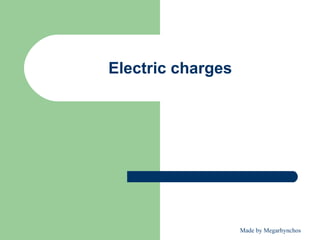Electric Charges
•Download as PPT, PDF•
0 likes•522 views
Report
Share
Report
Share

Recommended
More Related Content
What's hot
What's hot (20)
Viewers also liked
Viewers also liked (7)
Similar to Electric Charges
Similar to Electric Charges (20)
Basic Electrical & Electronics Engineering MT-144-NSU(Theory).pptx

Basic Electrical & Electronics Engineering MT-144-NSU(Theory).pptx
Applied Chemistry, atomic and molecular structure, part 1, by Shiraz mahbob PhD

Applied Chemistry, atomic and molecular structure, part 1, by Shiraz mahbob PhD
Recently uploaded
https://app.box.com/s/cbgl8f0rgcll2fzdqp83sjxx8nom8188TỔNG HỢP HƠN 100 ĐỀ THI THỬ TỐT NGHIỆP THPT VẬT LÝ 2024 - TỪ CÁC TRƯỜNG, TRƯ...

TỔNG HỢP HƠN 100 ĐỀ THI THỬ TỐT NGHIỆP THPT VẬT LÝ 2024 - TỪ CÁC TRƯỜNG, TRƯ...Nguyen Thanh Tu Collection
Recently uploaded (20)
TỔNG HỢP HƠN 100 ĐỀ THI THỬ TỐT NGHIỆP THPT VẬT LÝ 2024 - TỪ CÁC TRƯỜNG, TRƯ...

TỔNG HỢP HƠN 100 ĐỀ THI THỬ TỐT NGHIỆP THPT VẬT LÝ 2024 - TỪ CÁC TRƯỜNG, TRƯ...
Features of Video Calls in the Discuss Module in Odoo 17

Features of Video Calls in the Discuss Module in Odoo 17
UNIT – IV_PCI Complaints: Complaints and evaluation of complaints, Handling o...

UNIT – IV_PCI Complaints: Complaints and evaluation of complaints, Handling o...
Basic Civil Engineering notes on Transportation Engineering, Modes of Transpo...

Basic Civil Engineering notes on Transportation Engineering, Modes of Transpo...
Exploring Gemini AI and Integration with MuleSoft | MuleSoft Mysore Meetup #45

Exploring Gemini AI and Integration with MuleSoft | MuleSoft Mysore Meetup #45
Pragya Champions Chalice 2024 Prelims & Finals Q/A set, General Quiz

Pragya Champions Chalice 2024 Prelims & Finals Q/A set, General Quiz
Post Exam Fun(da) Intra UEM General Quiz - Finals.pdf

Post Exam Fun(da) Intra UEM General Quiz - Finals.pdf
Danh sách HSG Bộ môn cấp trường - Cấp THPT.pdf

Danh sách HSG Bộ môn cấp trường - Cấp THPT.pdf
Incoming and Outgoing Shipments in 2 STEPS Using Odoo 17

Incoming and Outgoing Shipments in 2 STEPS Using Odoo 17
Telling Your Story_ Simple Steps to Build Your Nonprofit's Brand Webinar.pdf

Telling Your Story_ Simple Steps to Build Your Nonprofit's Brand Webinar.pdf
Electric Charges
- 1. Electric charges Made by Megarhynchos
- 2. On the knowledge of atom structure of substances, you can conclude: Atom is built from core and electric layer. In the core there are protons and neutrons. Electric layer has minimum of one, and maximum of eight electric shells through which electrons are circled in. Made by Megarhynchos
- 3. The carriers of charge are electrons and protons. Electron has the smallest negative elemental charge: e0-= -1.6.10-19 C. Proton has the smallest positive elemental charge: e0+= +1.6.10-19 C. The charges of electron and proton have the same amount. Neutron is electrically neutral, and its mass is closely equal to the mass of proton. Made by Megarhynchos
- 4. When the amount of positive and negative charge is equal, the object works like neutral. The basic measure unit for electric charge is coulomb, mark is C or ampere second, C = A . s. The amount of charge from one coulomb fits to 6,24 trillion elemental particles of charge: 1 C = 6,24.1018 .e0 . Made by Megarhynchos
- 5. The total amount of charge which appears on objects (Q) can be calculated as product of numbers of elemental particles (n) and their elemental charge e0: Q = n . e0. Protons and electrons as the carriers of elemental charge with different algebraic sign, attract between each other. Electrons as the particles with the same sign, mutually reject themselves. Made by Megarhynchos
- 6. The particles of the same charge are rejecting, and the particles of the different charge are attracting between each other. With the fact that atoms of substances in balanced state, have the same amount protons and electrons, as one, is neutral. Energy of electron is bigger or smaller, depending about whether is electron further or closer to the core, or in which shell he is. Made by Megarhynchos
- 7. Energetic shells are energetic levels, and electron, as every physical object, seeks to take the place of the lowest energetic level in which he posses minimum energy. That’s why electrons first fill shells that are closer to the core. Electron from the lower energetic level, can pass to high by only under the effect of the outer incentive, and when that incentive stops, he is returned to the original first level. Made by Megarhynchos
- 8. From that we can conclude: How much energy electron gets from outer forces when he is passing to a high level, that’s how many energy will release when he is returning to a first original lower level. Electrons can leave from outer shell of atom by activity of outer forces, friction, light or heat. With that activity, it comes to unbalanced charges, or number of electrons and protons in atom is not equal anymore. Made by Megarhynchos
- 9. By distracting the balance of charge, the object begins to electrically wok and finds itself in a state of electrical compactness. Electrons which abandoned their atom became free, and are moving in inter space between atom or they bind to the core of the neighbor’s atom. Atom with the shortage of electrons is called positive ion. Atom with the excess of electrons is called negative ion. Made by Megarhynchos
- 10. Ions are atoms and molecules with excess or shortage of electrons. Ionization is process of liberation of electrons from atoms and creating free electrons Negative charged object has excess electrons, so the process of charging is made of adding electrons. Positive charged object has shortage of electrons, so the process of charging is made of seizure of electrons. Made by Megarhynchos